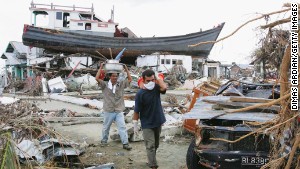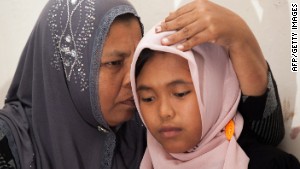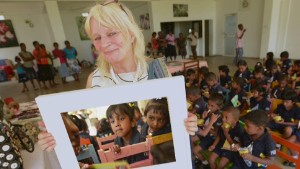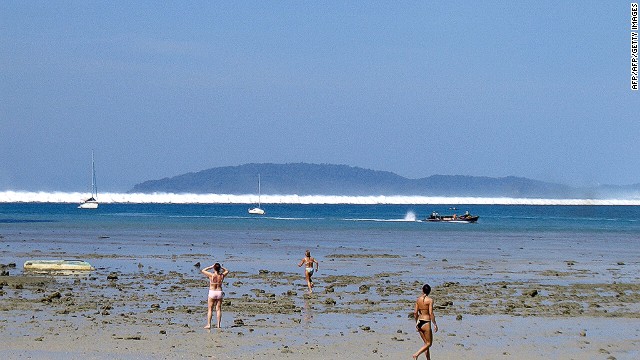Ten years on from the Indian Ocean tsunami -- are we safer now?
December 24, 2014 -- Updated 0254 GMT (1054 HKT)
Editor's note: As the Under Secretary General of National Society and Knowledge Development at the International Federation of Red Cross and Red Crescent Societies (IFRC),
Matthias Schmale is responsible for overseeing the Secretariat's work
with its 189 Red Cross and Red Crescent National Societies worldwide. He
has served in countries including Ethiopia, Tanzania, Zimbabwe, Sudan
and Kenya in field operations, program management and organizational
development.
(CNN) -- Most of us can clearly recall where we were
on December 26, 2004, when a massive earthquake off the northern coast
of Sumatra, Indonesia triggered a deadly tsunami that swept across the
Indian Ocean, killing more than 226,000 people and causing massive
destruction along coastal areas of 14 countries.
The tsunami caused one of
the worst natural disasters in recent memory, as its full horror
unfolded on TV screens around the world.
Ten years on, it is
important to reflect on what the tsunami has taught us and whether these
communities are any safer from such disasters.
One clear lesson
reinforced by the tsunami has been the importance of investing in
disaster risk reduction (DRR) at both global and local levels.

Matthias Schmale
In January 2005, The
Hyogo Framework for Action (HFA) -- a global blueprint for disaster risk
reduction efforts with a ten-year plan -- was adopted by 168
governments. Its goal was to substantially reduce disaster losses by
2015 by building the resilience of nations and communities to disasters.
In June 2006, the Indian
Ocean Tsunami Warning System became active, consisting of 25
seismographic stations -- used to detect earthquakes early -- relaying
information to 26 national tsunami information centers. This has
resulted in timely evacuations of mass populations when alerts are
sounded.
Removing red tape
The tsunami also
highlighted how weak legislation led to blockages and major coordination
challenges in the delivery of international assistance. The Hyogo
Framework for Action calls for improved legislation to facilitate
international disaster response, an area where the International
Federation of Red Cross and Red Crescent Societies (IFRC) has been
working closely with governments through its Disaster Laws program.
 Warning system changes since 2004 tsunami
Warning system changes since 2004 tsunami
 Tsunami victim found 10 years later
Tsunami victim found 10 years later
 Hope for children in Sri Lanka
Hope for children in Sri Lanka
Twelve countries in Asia
Pacific have made, or are progressing towards, legislative or
regulatory changes. These include Indonesia, where the National Disaster
Management Authority has revised its regulations relating to the
participation of the international community in national emergencies.
Another example is the Philippines, where, following Typhoon Haiyan in
2013, the government relaxed immigration requirements and established
one-stop-shops to streamline the clearance process for incoming goods
and equipment.
But global and national initiatives need to go hand-in-hand with investment in locally driven approaches towards reducing risk.
Working with communities
to help them be better prepared to face future disasters was the thread
that ran through the IFRC's recovery efforts after the tsunami.
Supporting the rebuilding of physical infrastructure, including 57,000
new homes, was one step, but establishing community based disaster risk
management programs was equally important. Sea search and rescue teams
were set up in Thailand, training was given to thousands of
first-responders in Sri Lanka, and early warning systems -- using HF
Radio -- were established across Indonesia alongside mangrove planting
projects to reduce the impact of coastal flooding. The legacy of those
initiatives lives on today.
Improving communication
Community participation
and engagement in risk reduction is vital and the tsunami cast a
spotlight on the need to improve accountability and two-way
communication with crisis affected communities. In Aceh, Indonesia,
traditional and hi-tech approaches were used to enable people to raise
questions or air concerns about the aid effort via community meetings,
live radio and SMS. Such approaches have since become integral aspects
of major operations and have proved essential in health promotion and
social mobilization campaigns.
Next year, the Third U.N. World Conference on Risk Reduction takes
place in Japan where HFA 2 will take shape. This represents a unique
opportunity to re-focus attention on the need for greater investment in
community level disaster risk reduction.
This means recognizing
that local people and organizations are first responders in emergencies;
understanding that they must be the drivers of change in their
communities as they have the best understanding of the risks they face.
It also means investing in strengthening the risk reduction capacities
of local, city and regional authorities.
While we can't prevent
another tsunami, we do know that many people in harms way today are now
more aware and better prepared to face future disasters. The challenge
ahead remains how we align global and local action to safeguard future
generations.

 Foreign tourists react as the
first of six tsunami start to roll towards Hat Rai Lay Beach, near Krabi
in southern Thailand on December 26, 2004. The 2004 Indian Ocean
tsunami caused massive destruction along coastal areas of 14 countries,
including Thailand, India, Sri Lanka, Indonesia and Malaysia.
Foreign tourists react as the
first of six tsunami start to roll towards Hat Rai Lay Beach, near Krabi
in southern Thailand on December 26, 2004. The 2004 Indian Ocean
tsunami caused massive destruction along coastal areas of 14 countries,
including Thailand, India, Sri Lanka, Indonesia and Malaysia.
ไม่มีความคิดเห็น:
แสดงความคิดเห็น